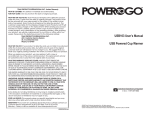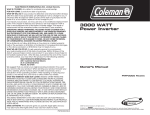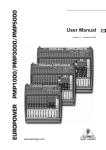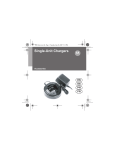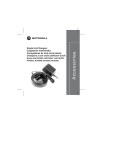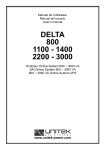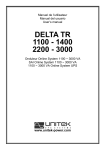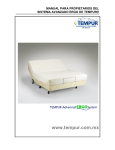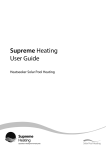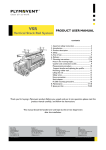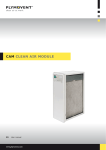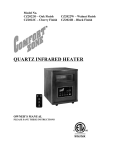Download Coleman PMP3000 Owner`s manual
Transcript
TEAM PRODUCTS INTERNATIONAL INC. Limited Warranty WHAT IS COVERED: Any defect in materials and workmanship. FOR HOW LONG: Two (2) years from the date of original purchase. WHAT WE ASK YOU TO DO: Team Products International, Inc. (“TPI”) will replace the defective product within the two (2) years from the date of original purchase. The product must first be returned with your sales receipt to the retailer. If the retailer’s return policy has expired, TPI will replace the defective product. The customer is responsible for the shipping charges to TPI, but TPI will incur the shipping charges on the replacement. When sending your product include your name, address, phone number, copy of proof of date of purchase (receipt), and a description of the operating problem. After receiving your product, we will ship a replacement to your home or office within four weeks. Please return the defective product to the following address: Alco Industries, Inc c/o TEAM PRODUCTS INTERNATIONAL, Returns 111A Melrich Road Cranbury, NJ 08512 WHAT WE WILL DO: If your product is defective and was not able to be returned within the in store return policy date, but within two (2) years of the original purchase date we will replace it at no charge to you. We suggest that you retain your original packing material in the event you need to ship your product. 3000 WATT Power Inverter Invertidor de Corriente de 3000 WATS When we replace your product, we may replace it with a new or reconditioned one of the same or similar product. The replacement will only be warranted two (2) years from the original date of purchase. WHAT THIS WARRANTY DOES NOT COVER: AMONG OTHER THINGS THIS WARRANTY DOES NOT COVER DEFECTS RESULTING FROM ACCIDENTS, DAMAGE WHILE IN TRANSIT TO OUR SERVICE LOCATION, ALTERATIONS, UNAUTHORIZED REPAIR, FAILURE TO FOLLOW INSTRUCTIONS, MISUSE, FIRE, FLOOD, WAR, AND ACTS OF GOD. IF YOUR PRODUCT IS NOT COVERED BY OUR WARRANTY, CALL OUR CUSTOMER SERVICE DEPARTMENT AT (888) 231-4022 TO DISCUSS FURTHER OPTIONS. THIS LIMITED WARRANTY IS THE ONLY ONE WE GIVE ON YOUR PRODUCT, AND IT SETS FORTH ALL OUR RESPONSIBILITIES REGARDING YOUR PRODUCT. THERE ARE NO WARRANTIES WHICH EXTEND BEYOND THE DESCRIPTION SET FORTH ABOVE. Owner’s Manual Manual del Usuario PMP3000 Models Modelos PMP3000 LIMITATIONS: IMPLIED WARRANTIES, INCLUDING THOSE OF FITNESS FOR A PARTICULAR PURPOSE AND MERCHANTABILITY (AN UNWRITTEN WARRANTY THAT THE PRODUCT IS FIT FOR ORDINARY USE), ARE LIMITED TO TWO (2) YEARS FROM ORIGINAL DATE OF PURCHASE. WE WILL NOT PAY FOR LOSS OF TIME, INCONVENIENCE, LOSS OF USE OF YOUR PRODUCT OR PROPERTY DAMAGE CAUSED BY YOUR PRODUCT OR ITS FAILURE TO WORK, OR ANY OTHER INCIDENTAL OR CONSEQUENTIAL DAMAGES INCLUDING PERSONAL INJURY. Questions?/¿Preguntas? in U.S. : 1-888-231-4022 SOME STATES DO NOT ALLOW LIMITATIONS ON HOW LONG AN IMPLIED WARRANTY LASTS OR THE EXCLUSION OR LIMITATION OF INCIDENTAL OR CONSEQUENTIAL DAMAGES, SO THE ABOVE EXCLUSIONS OR LIMITATIONS MAY NOT APPLY TO YOU. STATE LAW RIGHTS: This warranty gives you specific legal rights and you may also have other rights which may vary from state to state. QUESTIONS? If you have any questions about this product, please contact our Customer Service Department at (888) 231-4022, 9 am to 5 pm EST, Monday – Friday or visit our website at: www.teamproducts.com. PMP3000032607-235 © 2007 The Coleman Company, Inc.. All Rights Reserved. Made in China. Coleman® and are registered trademarks of The Coleman Company, Inc. used under license. © 2007 Todos los derechos reservados por The Coleman Company, Inc. Hecho en China. Coleman® y son marcas registradas de The Coleman Company, Inc. usadas bajo licencia. Owner’s Manual Manual del Usuario PMP3000 Models Modelos PMP3000 Rear Panel Welcome This COLEMAN® product has been carefully engineered and manufactured to give you dependable operation. Please read this manual thoroughly before operating your new COLEMAN® product, as it contains the information you need to become familiar with its features and obtain the performance that will bring you continued enjoyment for many years. Please keep this manual on file for future reference. 10 7. Power Input Terminal Red = Positive 8. Power Input Terminal Black = Negative 9. Ground Lug Terminal 10. Cooling Fan How Power Inverters Work Power inverters convert low voltage DC (direct current) power to 120 volt AC (alternating current) household power. This conversion process thereby allows you to use household products, power tools, and other electronic products away from normal AC power sources (standard 120V wall outlets). Depending on the model and its rated capacity, inverters can draw power either from standard 12-volt automobile and marine batteries or from portable high power 12-volt power sources. The waveform that is generated by this conversion is a “modified sine wave”. The modified sine wave produced by our inverters has a root square mean (RMS) voltage of 120 volts, which is the same as standard household power. The majority of AC voltmeters are calibrated for RMS voltage under the assumption that the measured waveform will be a pure sine wave. Therefore, these meters will not read the RMS modified sine wave voltage correctly. They will read about 20 to 30 volts too low. To accurately measure the output voltage of the inverter, use a true RMS reading voltmeter such as a Fluke 87, Fluke 8060A, Beckman 4410, Triplett 4200 or any voltmeter identified as a “true RMS”. Controls and Components 5 Front Panel 9 8 CAUTION • The inverter is designed to operate from a 12-volt power source only. The unit will not operate from a 6-volt battery or a 24-volt battery. Do not attempt to connect the inverter to any other power source other than a battery with a nominal output voltage of 12 volts or damage to the unit may occur and will void the warranty. • 120 volts can inflict serious injury, damage or death. Improper use of the inverter may result in property damage, personal injury or loss of life. Getting Started When you turn on an appliance or tool that operates using a motor or a tube (such as a television), it requires an initial surge of power to start up. This surge of power is referred to as the “starting load” or “peak load”. Once started, the appliance or tool requires less power to continue to operate. This is referred to as the “continuous load”. You will need to determine how much power your appliance or tool requires to start up (peak power) and it’s continued operating power requirements (continuous load). 4 1. LED Indicator Light (Green = Power ON, Red = Overload) 7 Power consumption is rated in either wattage (watts) or amperes (amps). This information is usually stamped or printed on most appliances and equipment. If this information is not indicated on the actual product, check the owner’s manual or contact the manufacturer to determine the power consumption. Be sure that the power consumption of the item you wish to operate is rated at 3000 watts or less. 2. Remote Control Connection 3. ON/OFF Power Switch 4. Digial Display 5. Display Selector Switch Multiply: AMPS x 120 (AC voltage) = WATTS 6. 120 Volt AC Outlets This formula yields a close approximation of the continuous load of the appliance. 3 2 1 1 6 To determine whether the inverter will operate a particular item, run a test. All COLEMAN® inverters are designed to automatically shut down in the event of a power overload. This protection feature prevents damage to the unit while testing items with ratings in the 3000-watt range. 2 Owner’s Manual Manual del Usuario PMP3000 Models Modelos PMP3000 Connecting the Inverter Notes When connecting the inverter to the power source, it is recommended to use the thickest wire available in the shortest length possible. If the inverter and the battery are positioned within 4 feet of each other, a minimum of #0 gauge wire should be used to make the connections. When the distance between them is 4 to 6 feet, a minimum of #00 gauge wire is required. When separated by more than six feet, contact a qualified technician to determine the appropriate wire size to use given the distance between the inverter and the battery. • Loose connections can result in a severe decrease in voltage, which may cause damage to the component or the product you wish to operate. 1. Make sure the ON/OFF power switch located on the front panel of the inverter is in the OFF(O) position. 2. Loosen and remove the bolts and nuts from the red (+) and black (-) power input terminals. 3. It is recommended to use a crimped “loop style” connector on the ends of the cables when connecting the cables to the inverter. 4. Connect the cable wires to the power input terminals making sure to match the color coded cables to the color coded terminals on the inverter (RED= Positive, BLACK = Negative). Tighten the bolts and nuts to secure the cables. Be sure not to over tighten. Note: A secure connection is essential to proper operation of the inverter. Be certain to use the supplied bolts, nuts and washers included to connect the cables. 5. Connect the cable from the Positive (+) terminal (RED) on the inverter to the Positive terminal on the power source. Double check that the connection is secure. 6. Locate the Ground Lug Terminal at the rear of the inverter. Run a wire from this terminal to a proper grounding point using the shortest practical length. It is recommended to use a minimum of 12 AWG wire. You can connect this wire to the chassis of your vehicle or to the grounding system in your boat. As an alternative, when in remote locations the ground wire can be connected to the earth (one way to accomplish this is to attach the wire to a metal rod driven into the ground). Before connecting to the ground, make certain that the inverter is turned off. Operation the inverter without correctly grounding the unit may result in electrical shock. 7. Turn the inverter power switch to the ON(I) position. The LED Indicator Light should illuminate GREEN to confirm that power is running to the inverter. 8. Turn the inverter power switch to the OFF(O) position. (The LED Indicator Light may “blink” briefly and/or the internal audible alarm may make a momentary “chirp”. This is normal). • Failure to make a proper connection between the inverter and the power source may result in reverse polarity. Reverse polarity will blow the internal fuses in the inverter and may cause permanent damage to the inverter. Damage caused by reverse polarity is not covered under the warranty. • The audible alarm may make a momentary “chirp” when the inverter is turned ON(I) or OFF(O). This same alarm may also sound when the inverter is being connected to or disconnected from the 12-volt power source. This is normal. • If the LED Indicator Light blinks when you first turn the inverter ON(I), this may indicate an interruption of the power supply. Simply turn the inverter OFF(O) and try removing and reconnecting the clamps. If this does not fix the problem, try using a different 12-volt power source. • If using more than one appliance, do not exceed a combined total of 3000 watts. Source of Power Most automobile, truck and marine batteries will provide an ample power supply to the inverter for 30 to 60 minutes even when the engine is turned off. Actual time may vary depending on the age and condition of the battery and the power demand being placed on it by the equipment being operated. If you decide to use the inverter while the engine is off, we recommend that you start the engine every 30 to 60 minutes and let it run for approximately 10 minutes to recharge the battery. It is also recommended that the device plugged into the inverter be turned OFF before starting the vehicle engine. Although it is not necessary to disconnect the inverter when starting the vehicle engine, it may momentarily cease to operate as the battery voltage decreases. When the inverter is not supplying power, it draws very low amperage from the battery. It is recommend that the inverter always be disconnected when not in use. Note: Always disconnect the power inverter from the 12-volt power source and make sure the inverter is turned OFF before replacing the fuse. Safety and Usage Precautions 9. Make sure that the device you intend to operate is turned OFF. Plug the cord from the equipment you wish to operate into one of the AC outlets located on the front panel of the inverter. • For best operating results, place the inverter on a flat surface 10. Turn the inverter power switch to the ON(I) position. Then turn the equipment on. • DO NOT operate the inverter if you, the inverter, the device being operated, or any surface that may come into contact with the inverter are wet. Water and other liquids can conduct electricity, which may lead to serious injury or death. 3 • Keep inverter dry. Do not expose inverter to rain or moisture. 4 Owner’s Manual Manual del Usuario PMP3000 Models Modelos PMP3000 • Avoid placing the inverter on or near heating vents, radiators or other sources of heat. Do not place or use the inverter in direct sunlight. Ideal air temperatures should be between 50° and 80° F. • In order to properly disperse the heat generated from the inverter while it is operating, keep the inverter well ventilated. Keep the area surrounding the inverter clear while in use. • Do not use the inverter near flammable materials. Do not place the inverter in areas such as battery compartments where fumes or gases may accumulate. Inverter Protection Features • Short Circuit Protection. The inverter will automatically shut down until short is removed. • Low Voltage Alarm. An alarm will sound when the voltage from the battery discharges to 10.5 +/- 0.5 volts DC. This is an indication that the battery needs to be recharged. • Over Voltage Protection. The RED LED Indicator Light will illuminate and the inverter will automatically turn itself off when the input exceeds 16.5 +/- 1 volt DC. • Under Voltage Protection. The RED LED Indicator Light will illuminate and the inverter will automatically turn itself off when the input is less than 10.0 +/- 0.5 volts DC. • Overload Protection. The RED LED Indicator Light will illuminate and the inverter will automatically turn itself off when the continuous draw of the equipment being operated exceeds 3000 watts or the surge draw of the equipment exceeds 6000 watts. • Thermal Protection. The RED LED Indicator Light will illuminate and the inverter will automatically turn itself off when the circuit temperature exceeds 150° F. Digital Display When the selector switch is in the “watt” position, the display will indicate the total wattage being produced by the inverter. This will vary depending on the appliance being operated by the inverter. If the reading is over 3000 watts, the inverter will automatically shut down. This most often happens when the current draw of the appliance being operated is greater than the inverter is capable of producing. When the selector switch is in the “volt” position, the display will indicate the input “voltage” from the battery. The inverter will operate with input voltage ranging from 11 to 15 volts of direct current (DC). If the voltage level falls below 10.5 +/- 0.5 volts DC, an audible alarm will sound. Should the voltage drop below 10 +/- 0.5 volts DC, the inverter will automatically shut down. The inverter may be damaged if the input voltage exceeds 15 volts, and the inverter will automatically shut down. However, despite this safety feature, excessive voltage may cause damage to the inverter. Damage caused by excess voltage input is not covered under the warranty. Television and Audio Suggestions Although all COLEMAN® inverters are shielded and filtered to minimize signal interference, some interference with your television picture may be unavoidable, especially with weak signals. However, here are some suggestions that may improve reception: • Make sure the television antenna produces a clear signal under normal operating conditions (at home plugged into a standard 120 volt AC outlet). Also, ensure that the antenna cable is properly shielded and/or good quality. • Change the positions of the inverter, antenna cables and the television power cord. • Isolate the television, its power cord and antenna cables from the 12-volt power source by running an extension cord from the inverter to the television set. • Coil the television power cord and the input cables running from the 12-volt power source to the inverter. Notes • The inverter is equipped with a cooling fan, which is not designed to run continuously. When the temperature inside the inverter exceeds the limits of safe operation, the cooling fan will automatically turn on to cool the inverter. When the temperature has lowered to a safe operating degree, it will shut off. • In the event of automatic shut down or a continuous audible alarm, turn the inverter power switch to the OFF(O) position until the source of the problem has been determined and resolved. 5 • Attach an AC interference filter or similar product between the inverter and the television power cord. These filters are available at most electronic supply stores, including Radio Shack. Note: Inexpensive sound systems may emit a “buzzing” sound when operated with an inverter. This is due to the inadequate filters in the sound system. There is no solution to this problem other than purchasing a sound system with a higher quality power supply. 6 Owner’s Manual Manual del Usuario PMP3000 Models Modelos PMP3000 Troubleshooting In Review • Never attempt to operate the inverter from any other power source other than a 12-volt battery. PROBLEM: Low or No Output Voltage • When connecting and using the inverter, make sure that the inverter is positioned far away from any potential source of flammable fumes or gases. Reason Solution • Make certain that the power consumption of the equipment you wish to operate is compatible with the capacity of the inverter. Do not exceed 3000 watts in total power, or 1600 watts for each individual AC outlet. Poor contact with battery terminals. Clean terminals thoroughly. Reattach battery clips. Using incorrect type of voltmeter to test output voltage. Use true RMS reading meter. • When attempting to operate battery chargers, monitor the temperature of the battery charger for approximately 10 minutes. If the battery charger becomes abnormally warm, disconnect it from the inverter immediately. • Use only 30 amp spade type fuses for the inverter. • When operating the inverter with an automobile or marine battery, start the engine every 30 to 60 minutes and let it run for approximately 10 minutes to recharge the battery. • In the event of a continuous audible alarm or an automatic shut down of the unit, turn the inverter OFF immediately. Do not turn the inverter ON again until the source of the problem has been identified and corrected. PROBLEM: Red LED On Reason Solution Battery voltage below 10.0 ± 0.5 volts. Recharge or replace battery. Equipment being operated draws too much power. Use a higher capacity inverter or do not use this equipment. Inverter is too hot (thermal shutdown mode). Allow inverter to cool. Check for adequate ventilation. Reduce the load on the inverter to rated continuous power output Unit may be defective. See Warranty and call Customer service at 1-888-231-4022. • To avoid battery drain, always disconnect the inverter when not in use. • Do not expose the inverter to rain or moisture. • Avoid placing the inverter near sources of heat or in direct sunlight. • While in use, make sure that the inverter is properly ventilated. • For best operating results, make sure the unit is placed on a flat surface. 7 8 Owner’s Manual Manual del Usuario PMP3000 Models Modelos PMP3000 Troubleshooting Specifications: PROBLEM: TV Interference Reason Solution Electrical interference from the inverter. Add an AC interference filter on to the TV power cord. Refer to TV and audio section of this manual. PROBLEM: Low Battery Alarm On All The Time Maximum Continuous Power 3000 Watts Surge Capacity (Peak Power) 6000 Watts Max Power Efficiency >80% Waveform Modified Sine Wave No Load Current Draw <3.5A Input Voltage Range 11-15VDC AC Receptacles 120V AC, Grounded Fuse 15 x 30 amp (spade type) Weight 18.5 lbs. 19.9” (L) x 9.055”(W) x 6.14” (H) 505mm(L) x 230mm(W) x 156mm(H) Reason Solution Dimensions Input voltage below 10.5 ± 0.5 volts. Keep input voltage above 10.5±0.5 volts to maintain regulation. Poor or weak battery condition. Recharge or replace battery. Inadequate power being delivered to the inverter or excessive voltage drop. Make sure connection is secure. Use lower gauge wire. Keep wire length as short as possible. Questions? If you have any questions about this product, please contact our Customer Service Department at (888) 231-4022, Monday through Friday, 9 AM to 5 PM EST, or visit our website at www.teamproducts.com. PROBLEM: TV Does Not Work Reason Solution TV does not turn on. Try turning the inverter ON/OFF/ON. Contact TV manufacturer for start up surge and power consumption. A larger inverter may be required. 9 10 Owner’s Manual Manual del Usuario PMP3000 Models Modelos PMP3000 Bienvenido 10 Este producto COLEMAN® ha sido cuidadosamente diseñado y fabricado para brindarle una operación confiable. Por favor lea este manual completamente antes de usar su nuevo producto COLEMAN®, porque contiene la información que usted necesita para familiarizarse con sus características y para obtener el mejor funcionamiento que disfrutará continuamente por muchos años. Guarde este manual para referencia futura. Los invertidores de corriente convierten la corriente directa (CD) de bajo voltaje a corriente alterna (CA) de 120 voltios. Este proceso de conversión le permite operar artefactos del hogar, herramientas eléctricas y otros artefactos electrónicos cuando no se tiene una fuente de CA estándar de 120 voltios. Dependiendo del modelo y de la capacidad del invertidor, se puede obtener corriente de una batería estándar de 12 voltios automotriz o marina o de fuentes portátiles de corriente de 12 voltios de gran potencia. La forma de la onda que genera esta conversión es una “onda sinusoidal modificada” que tiene un voltaje de valor cuadrático medio (RMS) de 120 voltios, que es el mismo que se usa como estándar en las casas. La mayoría de voltímetros de CA están calibrados para voltaje RMS bajo la suposición de que la fonda medida será de forma sinusoidal perfecta. Por lo tanto, estos medidores no sirven para medir correctamente el voltaje de las ondas RMS sinusoidales modificas. Medirán 20 a 30 voltios menos. Para medir con precisión el voltaje de salida de un invertidor, se debe usar un voltímetro de RMS verdadero tal como un Fluke 87, Fluke 8060A, Beckman 4410, Triplett 4200 o cualquier voltímetro identificado como “RMS verdadero”. Controles y Componentes 5 1. Luz indicadora LED (Verde = Encendido, Rojo = Sobrecarga) 7. Terminal de entrada de corriente Rojo = Positivo 8. Terminal de entrada de corriente Negro =Negativo 9. Terminal de conexión a tierra Cómo Funcionan los Invertidores de Corriente Panel Frontal Panel Posterior 10. Ventilador de enfriamiento 9 7 8 PRECAUCIÓN • El invertidor está diseñado para operar únicamente con una fuente de corriente de 12 voltios. La unidad no funcionará con baterías de 6 ni de 24 voltios. No intente conectar el invertidor a otra fuente de corriente que no sea de un voltaje nominal de salida de 12 voltios porque se dañará la unidad y se anulará la garantía. • La corriente de 120 voltios puede causar lesiones serias, daños o muerte. El uso inapropiado del invertidor puede causar a la propiedad, lesiones personales o pérdida de vida. Preparación para Comenzar Cuando encienda algún artefacto o herramienta que opere con un motor o un tubo (como un televisor), necesita una sobrecarga inicial de corriente para arrancar que se conoce como “carga de arranque” o “carga pico”. Una vez que el artefacto arranca, continúa operando con menos corriente que se conoce como “carga continua”. Usted debe determinar cuanta corriente requiere el artefacto o herramienta para arrancar (potencia pico) y cuanta corriente requiere para continuar operando (carga continua). 4 5. Llave Selectora de Indicación El consumo de energía se mide ya sea en wataje (wats) o como amperaje (amperios). Esta información usualmente está estampada o impresa en la mayoría de artefactos o equipos. Si esta información no apareciese en la unidad que desea conectar, revise su manual del propietario o comuníquese con el fabricante para averiguar el consumo de energía. Asegúrese que el consumo de corriente del artefacto a operar sea de 3000 wats o menos. 6. Salidas de CA de 120 voltios Multiplique AMPS x 120 (voltaje CA) = WATS. 2. Conexión de Control Remoto 3. Interruptor para Encender/Apagar 4. Indicador Digital Con esta fórmula se obtiene la carga continua muy aproximada de un artefacto. 3 2 1 6 Para determinar si un invertidor hará funcionar un artefacto específico, haga una prueba. Todos los invertidores COLEMAN® están diseñados para apagarse automáticamente en caso de una sobrecarga. Este dispositivo de protección evita daños a la unidad cuando se prueban artefactos con potencia superior a 3000 wats. Owner’s Manual Manual del Usuario PMP3000 Models Modelos PMP3000 Conexión del Invertidor Notas: Al conectar el inversor a la fuente de alimentación, se recomienda utilizar el cable más grueso posible y del menor largo posible. Si el inversor y la batería se encuentran separados por menos de 4 pies, deberá usarse cable #0 como mínimo para hacer las conexiones. Si la distancia entre ellos es de 4 a 6 pies, se requiere cable #00 como mínimo. Si están separados por más de seis pies, llame a un electricista calificado para determinar el calibre adecuado para el cable de acuerdo con la distancia entre el inversor y la batería. • Las conexiones sueltas pueden causar caídas severas de voltaje que a su vez pueden dañar la unidad que se desea operar. 1. Asegúrese que el invertidor esté apagado con su interruptor en el panel frontal en la posición de (O). • Cuando el invertidor se encienda (I) o se apague (O), se escuchará momentáneamente un “chirrido” de alarma. Esta misma alarma también puede sonar cuando se conecta o se desconecta el invertidor a la fuente de corriente de 12 voltios. Esto es normal. 2. Afloje y quite los tornillos de los terminales de entrada de alimentación rojo (+) y negro (-). 3. Se recomienda usar un conector prensado “tipo anillo” en el extremo de los cables al conectarlos al inversor. 4. Conecte los cables a los terminales de entrada de energía asegurándose de respetar el código de colores en los cables y en los terminales del inversor (ROJO = Positivo, NEGRO = Negativo). Ajuste los tornillos y tuercas para asegurar los cables. No los ajuste de más. Nota: Una buena conexión es esencial para que el inversor funcione correctamente. Asegúrese de usar los tornillos, tuercas y arandelas suministrados para conectar los cables. 5. Conecte el terminal del cable positivo (+) (rojo) del invertidor al terminal positivo de la fuente de corriente. Revise dos veces que la conexión esté segura. 6. Localice el terminal de conexión a tierra en la parte posterior de la unidad. Conecte un cable desde este terminal hasta una toma de tierra adecuada usando la menor longitud posible. Se recomienda el uso de cable AWG 12 como mínimo. Puede conectar este cable al chasis de su vehículo o a la conexión a tierra de su bote. Como alternativa, en lugares remotos se puede conectar el cable de tierra al suelo (una forma de hacerlo es conectando el cable a una varilla metálica enterrada en el suelo). Asegúrese de que el inversor esté apagado antes de conectarlo a tierra. El usar el inversor sin conectarlo correctamente a tierra puede producir una descarga eléctrica. 7. Mueva la llave de encendido del inversor hacia la posición ON (I). El LED indicador VERDE debe iluminarse confirmando que el inversor está recibiendo energía. 8. Apague el invertidor colocando el interruptor en la posición (O). (El diodo de luz podría “destellar” brevemente y/o la alarma interna podría sonar momentáneamente con un “chirrido”. Esto es normal). 9. Cerciórese que la unidad que desea operar esté apagada y conecte su enchufe en una de las salidas de CA ubicadas en el panel frontal del invertidor. 10. Encienda el invertidor colocando su interruptor en la posición (I), y encienda el equipo que desea operar. • La conexión incorrecta entre el inversor y la fuente de alimentación puede causar una inversión de polaridad. La inversión de polaridad quemará los fusibles internos del inversor y puede dañarlo permanentemente. Los daños causados por una inversión de polaridad no están cubiertos por esta garantía. • Si el LED indicador parpadea al encender el inversor por primera vez (I), esto puede indicar una interrupción en la fuente de alimentación. Simplemente apague el inversor (0) y pruebe quitando y reconectando las pinzas. Si esto no soluciona el problema, pruebe utilizando otra fuente de energía de 12 voltios. • Si opera más de un artefacto, no exceda el total combinado de 3000 wats. Fuente de Corriente La mayoría de baterías automotrices y marinas proveerán suficiente corriente a un invertidor para 30 a 60 minutos, aunque el motor esté apagado. El tiempo real dependerá de la edad y condiciones de la batería y de la corriente que se le demande para operar el equipo. Si decide utilizar el invertidor con el motor esté apagado, recomendamos arrancarlo cada 30 a 60 minutos y dejarlo funcionar aproximadamente 10 minutos para recargar la batería. También se recomienda apagar el artefacto que se está operando con el invertidor antes de arrancar el motor del vehículo. No obstante que no es necesario desconectar el invertidor al arrancar el motor del vehículo, éste podría dejar de operar momentáneamente debido a la disminución del voltaje de la batería. Aunque el invertidor no esté suministrando corriente, demanda una pequeña cantidad de amperaje de la batería. Se recomienda que el invertidor siempre esté desconectado cuando no esté en uso. Nota: Siempre desconecte el invertidor de la fuente de corriente de 12 voltios y asegúrese que el invertidor esté apagado antes de cambiar el fusible. Seguridad y Precauciones para el Uso • Para mejores resultados, coloque el invertidor sobre una superficie plana. • Mantenga el invertidor seco. No lo exponga a la lluvia ni a la humedad. • No opere el invertidor si éste, usted o el artefacto que se va a operar o la superficie sobre la cual se coloque el invertidor están mojados. El agua y otros líquidos pueden conducir la electricidad que pueden causar lesiones serias o muerte. Owner’s Manual Manual del Usuario PMP3000 Models Modelos PMP3000 • Evite colocar el invertidor en o cerca de salidas de calefacción, radiadores u otras fuentes de calor. No coloque ni use el invertidor bajo la luz directa del sol. La temperatura ideal es entre 10°C / 50°F y 27°C/ 80°F. • Para dispersar adecuadamente el calor generado por el invertidor mientras está operando, manténgalo en un lugar bien ventilado. Mantenga el área alrededor del invertidor limpia mientras esté en uso. • No use el invertidor cerca de materiales inflamables. No coloque el invertidor en lugares tales como los compartimientos de las baterías donde pueden acumularse gases. Dispositivos de Protección del Invertidor • Protección Contra Cortocircuito: El invertidor se apagará automáticamente hasta que se elimine la causa del cortocircuito. • Alarma de Bajo Voltaje: Una alarma sonará cuando el voltaje de la batería caiga a 10,5 +/-0,5 voltios DC. Esto es una indicación de que la batería necesita cargarse. • Protección Contra Sobrevoltaje: El diodo de luz roja se encenderá y el invertidor se apagará automáticamente cuando la entrada de corriente directa exceda 16.5 +/- 1 voltio. Indicador Digital Cuando la llave selectora está en la posición “watt”, la pantalla indicará la potencia total (vatios) generada por el inversor. Esto variará dependiendo del artefacto alimentado por el inversor. Si la indicación es mayor a 3000 vatios el inversor se apagará automáticamente. Esto sucede a menudo cuando la corriente consumida por el artefacto utilizado es mayor que la que puede producir el inversor. Cuando la llave selectora está en la posición “volt”, la pantalla indicará el voltaje (voltios) proporcionado por la batería. El inversor funcionará con voltajes de entrada de 11 a 15 voltios de corriente continua (CC). Si el nivel de voltaje desciende por debajo de 10,5 +/- 0,5 voltios de CC, se activará una alarma sonora. Si el nivel de voltaje desciende por debajo de 10 +/- 0,5 voltios de CC, el inversor se apagará automáticamente. El inversor podría dañarse si el voltaje de entrada excede los 15 voltios, y se apagará automáticamente. Sin embargo, a pesar de esta característica de seguridad, el voltaje excesivo puede llegar a dañar el inversor. Los daños causados por voltaje de entrada excesivo no están cubiertos por la garantía. Sugerencias para Televisión y Equipos de Sonido • Protección Contra Subvoltaje: El diodo de luz roja se encenderá y el invertidor se apagará automáticamente cuando la entrada de corriente directa caiga a 10,5 +/-0,5 voltios. No obstante que los invertidores COLEMAN® están blindados y cuentan con filtros para minimizar las señales de interferencia, podría ser inevitable percibir una interferencia en la imagen del televisor, especialmente con las señales débiles. Sin embargo, aquí hay algunas sugerencias que pueden mejorar la recepción: • Protección Contra Sobredemanda: El diodo de luz roja se encenderá para indicar la sobre demanda y el invertidor se apagará automáticamente cuando el equipo operado excede una demanda de 400 wats o cuando hay una sobredemanda temporal que exceda 800 wats. • Cerciórese que la antena del televisor produzca una imagen clara bajo condiciones normales de operación (enchufado a un tomacorriente CA de 120 voltios en la casa). También asegúrese que el cable de la antena esté adecuadamente blindado y/o sea de buena calidad. • Protección Térmica: El diodo de luz roja se encenderá y el invertidor se apagará automáticamente cuando la temperatura del circuito exceda 66°C / 150°F. • Cambie la posición del invertidor, de los cables de la antena y del cordón de suministro eléctrico del televisor. Notas: • El inversor cuenta con un ventilador de enfriamiento, el cual no está diseñado para funcionar constantemente. Cuando la temperatura dentro del inversor excede los límites de seguridad, el ventilador se encenderá automáticamente para enfriar el inversor. Una vez que la temperatura descienda a un nivel seguro, se apagará. • En caso que el invertidor se apague automáticamente, o que la alarma suene en forma continuada, apague el invertidor colocando su interruptor en la posición (O) hasta que se determine la causa del problema y se resuelva. • Aísle el televisor, su cordón de suministro eléctrico y los cables de la antena de la fuente de suministro de 12 voltios usando un cordón de extensión conectado entre el invertidor y el televisor. • Enrolle el cordón de suministro eléctrico del televisor y los cables de entrada entre la fuente de corriente de 12 voltios y el invertidor. • Instale un filtro de interferencia para CA o un dispositivo similar en el cordón de suministro eléctrico entre el televisor y el invertidor. Estos filtros están disponibles en la mayoría de tiendas de suministros electrónicos. Nota: Los sistemas de sonido baratos pueden emitir un zumbido cuando funcionan mediante un invertidor. Esto se debe a los filtros inadecuados en el sistema de sonido. No existe solución para este problema, más que comprar un sistema de sonido de mayor calidad y potencia. Owner’s Manual Manual del Usuario PMP3000 Models Modelos PMP3000 En Resumen • Nunca intente operar el invertidor de una fuente de corriente que no sea una batería de 12 voltios. • Al conectar y usar un invertidor, cerciórese que esté colocado tan lejos como sea posible de cualquier fuente probable de emanaciones o gases inflamables. • Asegúrese que el consumo de corriente del equipo que se desea operar sea compatible con la capacidad del invertidor. No exceda los 3000 vatios de potencia total, o 1600 vatios por cada enchufe individual. • Al intentar operar cargadores de batería, supervise la temperatura del cargador de batería durante aproximadamente 10 minutos. Si el cargador de batería se vuelve anormalmente caliente, desconéctelo inmediatamente del invertidor. • Sólo use fusible tipo espada de 30 amperios en el invertidor. • Cuando opere el invertidor con una batería automotriz o marina, arranque el motor cada 30 a 60 minutos y déjelo funcionar por aproximadamente 10 minutos para que recargue la batería. • En el caso de escucharse la alarma en forma continuada o de un apagado automático del invertidor, ponga inmediatamente el interruptor en posición apagado (O). No vuelva a encender el invertidor hasta identificar y corregir la causa del problema. • Para evitar que la batería se descargue, siempre desconecte el invertidor cuando no esté en uso. • No exponga el invertidor a la lluvia o a la humedad. • Evite colocar el invertidor cerca de fuentes de calor o bajo la luz directa del sol. • Asegúrese que el invertidor esté debidamente ventilado cuando esté en uso. • Para mejores resultados de operación, asegúrese de colocar el invertidor sobre una superficie plana. Diagnóstico de Problemas PROBLEMA: No hay Voltaje de Salida o está Bajo Razón Mal contacto al tomacorriente del encendedor o los terminales de la batería. Uso de voltímetro incorrecto para medir el voltaje de salida. Solución Desenchufe y reenchufe el conector de 12 voltios o desconecte y reconecte las pinzas en la batería. Use un medidor de RMS verdadero. PROBLEMA: Luz Roja del Diodo Encendida Razón Solución El voltaje de la batería ha caído a 10,0 ± 0,5 voltios. Recargue o reemplace la batería. El equipo que se está operando demanda demasiada corriente. Use un invertidor de capacidad mayor o no use este equipo. El invertidor está demasiado caliente (modalidad de apagado térmico). Permita que el invertidor se enfríe. Revise que haya ventilación adecuada. Reduzca la carga demandada a la capacidad de carga continua del invertidor. La unidad podría estar defectuosa. Refiérase a la garantía y llame al Departamento de Servicios al Cliente al 1-888-231-4022 Owner’s Manual Manual del Usuario PMP3000 Models Modelos PMP3000 Diagnóstico de Problema Especificaciones: PROBLEMA: Interferencia en el TV Razón Interferencia eléctrica del invertidor. Solución Instale un filtro de interferencia de CA en el cordón de suministro eléctrico del TV. Refiérase a la sección TV y equipos de sonido en este manual. Corriente Continua Máxima: 3000 wats Capacidad de Sobrecarga (Potencia Pico): 6000 wats Eficiencia Máxima de Corriente: >80% Forma de Onda: Onda sinusoidal modificada Consumo de Corriente Sin Carga: <3.5A PROBLEMA: Alarma de Batería Baja Funcionando Todo el Tiempo Razón Solución El voltaje de entrada al invertidor a caído debajo de 10,5 ±0,5 voltios. Mantenga el voltaje de entrada encima de 10,5 ± 0,5 voltios. Batería débil o en malas condiciones. Recargue o cambie la batería. La corriente que entra al invertidor es inadecuada o hay una caída de voltaje excesiva. Revise la condición del tomacorriente del encendedor de cigarrillos. Límpielo o reemplácelo si fuese necesario. PROBLEMA: EL TELEVISOR NO FUNCIONA Razón El receptor de TV no enciende. Solución Pruebe apagando y volviendo a encender el invertidor. Comuníquese con el fabricante del TV para averiguar el consumo de corriente que requiere para encenderse. Puede requerir un invertidor de mayor capacidad. Rango de Voltaje de Entrada: 11 a 15 V CD Salidas de CA: 120V CA, con conexión a tierra. Fusible: 15 x 30 amperios (tipo de la espada) Peso: 8392gr. / 18,5Lbs. Dimensiones: Largo: 505mm (19.9”); Ancho 230mm (9.055”); Alto 157mm (6.14”). ¿PREGUNTAS? Si tiene alguna pregunta sobre este producto, por favor contacte a nuestro Departamento de Servicios al Cliente al (888) 231-4022, de lunes a viernes, de 9am a 5pm Hora del Este, o visite nuestro sitio web en www.teamproducts.com. Garantía limitada de TEAM PRODUCTS INTERNATIONAL INC. QUÉ CUBRE: Todo defecto en materiales o mano de obra. POR CUÁNTO TIEMPO: Dos (2) años a partir de la fecha de compra original. QUÉ PEDIMOS QUE HAGA: Hasta dos (2) años a partir de la fecha de compra original, Team Products International, Inc. (“TPI”) reemplazará todo producto defectuoso. Primero se debe regresar al vendedor detallista el producto junto con el recibo de venta. Si la póliza del vendedor detallista ha expirado, TPI reemplazará el producto defectuoso. El cliente es responsable de los cargos de envío hacia TPI, pero TPI pagará los cargos de envío del reemplazo. Al enviar el producto incluya su nombre, dirección, número de teléfono, una copia de la prueba de la fecha de compra (el recibo) y una explicación del problema de funcionamiento. Luego de recibir su producto, le enviaremos el reemplazo a su hogar u oficina dentro de cuatro semanas. Sírvase regresar el producto defectuoso a la siguiente dirección: Alco Industries, Inc c/o TEAM PRODUCTS INTERNATIONAL, Returns 111A Melrich Road Cranbury, NJ 08512 QUÉ HAREMOS: Si su producto tiene un defecto y no lo pudo regresar dentro de la fecha de la póliza para regreso a la tienda, pero no han transcurrido dos (2) años a partir de la fecha de compra original, lo reemplazaremos sin cargo para usted. Le sugerimos guardar el paquete original en caso de necesitar enviar el producto. Al reemplazar el producto, lo haremos por uno nuevo o reacondicionado igual o similar. El reemplazo estará garantizado solamente por dos (2) años a partir de la fecha de compra original. QUÉ NO CUBRE ESTA GARANTÍA: ENTRE OTRAS COSAS, ESTA GARANTÍA NO CUBRE DEFECTOS QUE RESULTEN DE ACCIDENTES, DAÑOS DURANTE EL TRANSPORTE HACIA NUESTROS TALLERES DE SERVICIO, ALTERACIONES, REPARACIONES NO AUTORIZADAS, FALTAS AL SEGUIR LAS INSTRUCCIONES, ABUSO, INCENDIOS, INUNDACIONES, GUERRAS Y ACTOS DE FUERZA MAYOR. SI SU PRODUCTO NO ESTÁ CUBIERTO POR NUESTRA GARANTÍA, LLAME A NUESTRO DEPARTAMENTO DE SERVICIO AL CLIENTE AL (888) 231-4022 PARA ESTUDIAR OTRAS OPCIONES. ESTA GARANTÍA LIMITADA ES LA ÚNICA QUE OTORGAMOS AL PRODUCTO Y EN ELLA SE DESCRIBE TODA NUESTRA RESPONSABILIDAD CON RESPECTO AL PRODUCTO. NO HAY NINGUNA OTRA GARANTÍA QUE SE EXTIENDA MÁS ALLÁ DE LO ANTERIORMENTE DESCRITO. LIMITACIONES: LAS GARANTÍAS IMPLÍCITAS, INCLUYENDO AQUELLAS DE ADECUACIÓN PARA UN PROPÓSITO EN PARTICULAR Y LAS DE COMERCIALIZACIÓN (GARANTÍAS NO ESCRITAS DE QUE EL PRODUCTO ES APTO PARA USO GENERAL) ESTÁN LIMITADAS A DOS (2) AÑOS A PARTIR DE LA FECHA DE COMPRA ORIGINAL. NO PAGAREMOS EN CONCEPTO DE TIEMPO PERDIDO, INCONVENIENCIA, PÉRDIDA DE USO DEL PRODUCTO NI DAÑOS A LA PROPIEDAD DEBIDO A NUESTRO PRODUCTO O A SU FALLA DE FUNCIONAMIENTO, NI TAMPOCO CUALQUIER OTRO DAÑO INCIDENTAL O CONSECUENTE INCLUYENDO LESIONES PERSONALES. Algunos estados no permiten las limitaciones al tiempo de duración de las garantías implícitas ni la exclusión o limitación de los daños incidentales o consecuentes, por lo que las exclusiones y limitaciones anteriores podrían no ser aplicables a usted. DERECHOS POR LEYES ESTATALES: Esta garantía le otorga derechos legales específicos y además podría gozar de otros, que pueden variar de un estado a otro. ¿PREGUNTAS? Si tiene cualquier pregunta acerca de este producto, sírvase contactar a nuestro departamento de servicio al cliente al (888) 231-4022, entre 9 AM y 5 PM hora estándar del este, de lunes a viernes o visite nuestro sitio web en: www.teamproducts.com. Owner’s Manual Manual del Usuario
This document in other languages
- español: Coleman PMP3000












